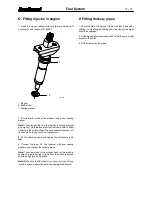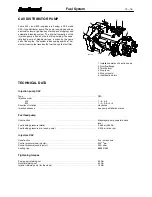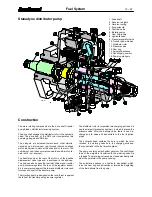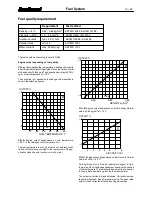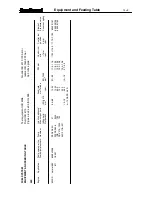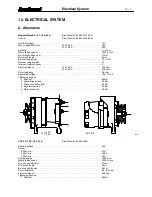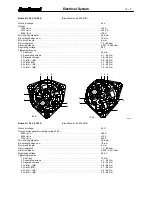
OUTPUT %
0,80
0,85
0,90
0,84
+5
0
---5
B
35
+5
0
---5
A
OUTPUT %
10
20
30
40
50
60
FUEL TEMPERATURE
˚
C
C
+5
0
---2
2
3
4
5
6
7
8
OUTPUT %
VISCOSITY cSt
Density, +15
˚
C
0,82...0,86 kg/dm
3
ASTM D 4052, EN ISO 12185
Viskosity, +40
˚
C
1,2...4,5 mm
2
/s
ASTM D 445, ISO 3104
Sulphur content
max. 0,2 % m/m
ASTM D 4294, ISO 8754
Cetane index
min. 45
ASTM D 4737
Water content
max. 200 mg/kg
ASTM D 1744
Requirement
Test method
DENSITY kg/dm
3
Fuel System
13---29
Fuel quality requirement
The fuel should be according to norm EN 590.
Engine output depending on fuel quality
Different fuel qualities like temperature, density and viscosity
affect the actual output of the engine. Our output rates use fuel
with a density of 0.84 kg/dm
3
and specific heat rate of 42,7 Mj/
kg at a fuel temperature of +15
˚
C.
The correction in % caused by the change of fuel qualities is
seen in the attached figures.
FIG.A.
Engine output dependence on fuel temperature.
+35
˚
C is the reference temp (correction 0 %).
The fuel temperature is not only a function of ambient condi-
tions but also varies according to the fuel system of the ap-
plication (tank size and location, return flow etc.).
FIG. B.
Engine output dependence on fuel density. Normal
value is 0,84 kg/dm
3
at +15
˚
C.
FIG. C.
Engine output dependence on fuel viscosity. Normal
value is 3 cSt at +20
˚
C.
Note fig. B and C only if the fuel quality is changed. In fig. A
there are all the quality dependencies caused by the change
of the temperature. The fuel density and viscosity can be seen
in the produce declaration given by the manufacturer.
The output correction is made as follows: Correction percen-
tages from figures A, B and C are summed up. The given rated
power is then corrected with the resulting percentage.

